Also available:
The Beer Token [Video]
This post is also available as an article. So if you'd rather read a conventional blog post of this content, you can!
This post is also available as an article. So if you'd rather read a conventional blog post of this content, you can!
This post is also available as a podcast. Listen here, download for later, or subscribe wherever you consume podcasts.
This post is also available as a video. If you'd prefer to watch/listen to me talk about this topic, give it a look.
The novelisation of The Hitch-Hiker’s Guide to the Galaxy came out in 1979, just a smidge before I was born. There’s a well-known scene in the second chapter featuring Ford Prefect, an alien living on Earth, distracting his human friend Arthur Dent. Arthur is concerned about the imminent demolition of his house by a wrecking crew, and Ford takes him to the pub to get him drunk, in anticipation of the pair attempting to hitch a lift on an orbiting spacecraft that’s about to destroy the planet:
“Six pints of bitter,” said Ford Prefect to the barman of the Horse and Groom. “And quickly please, the world’s about to end.”
The barman of the Horse and Groom didn’t deserve this sort of treatment, he was a dignified old man. He pushed his glasses up his nose and blinked at Ford Prefect. Ford ignored him and stared out of the window, so the barman looked instead at Arthur who shrugged helplessly and said nothing.
So the barman said, “Oh yes sir? Nice weather for it,” and started pulling pints.
He tried again.
“Going to watch the match this afternoon then?”
Ford glanced round at him.
“No, no point,” he said, and looked back out of the window.
“What’s that, foregone conclusion then you reckon sir?” said the barman. “Arsenal without a chance?”
“No, no,” said Ford, “it’s just that the world’s about to end.”
“Oh yes sir, so you said,” said the barman, looking over his glasses this time at Arthur. “Lucky escape for Arsenal if it did.”
Ford looked back at him, genuinely surprised.
“No, not really,” he said. He frowned.
The barman breathed in heavily. “There you are sir, six pints,” he said.
Arthur smiled at him wanly and shrugged again. He turned and smiled wanly at the rest of the pub just in case any of them had heard what was going on.
None of them had, and none of them could understand what he was smiling at them for.
A man sitting next to Ford at the bar looked at the two men, looked at the six pints, did a swift burst of mental arithmetic, arrived at an answer he liked and grinned a stupid hopeful grin at them.
“Get off,” said Ford, “They’re ours,” giving him a look that would have an Algolian Suntiger get on with what it was doing.
Ford slapped a five-pound note on the bar. He said, “Keep the change.”
“What, from a fiver? Thank you sir.”
There’s a few great jokes there, but I’m interested in the final line. Ford buys six pints of bitter, pays with a five-pound note, and says “keep the change”, which surprises the barman. Presumably this is as a result of Ford’s perceived generosity… though of course what’s really happening is that Ford has no use for Earth money any longer; this point is hammered home for the barman and nearby patrons when Ford later buys four packets of peanuts, also asking the barman to keep the change from a fiver.

We’re never told exactly what the barman would have charged Ford. But looking at the history of average UK beer prices and assuming that the story is set in 1979, we can assume that the pints will have been around 34p each1, so around £2.04 for six of them. So… Ford left a 194% tip for the beer2.
By the time I first read Hitch-Hikers, around 1990, this joke was already dated. By then, an average pint of bitter would set you back £1.10. I didn’t have a good awareness of that, being as I was well-underage to be buying myself alcohol! But I clearly had enough of an awareness that my dad took the time to explain the joke… that is, to point out that when the story was written (and is presumably set), six pints would cost less than half of five pounds.
But by the mid-nineties, when I’d found a friend group who were also familiar with the Hitch-Hikers… series, we’d joke about it. Like pointing out that by then if you told the barman to keep the change from £5 after buying six pints, the reason he’d express surprise wouldn’t be because you’d overpaid…
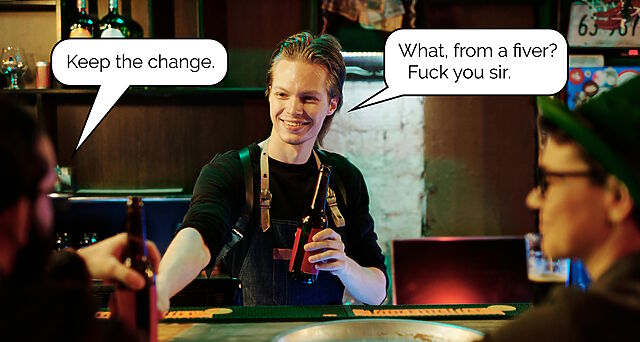
Precocious drinker that I was, by the late nineties I was quite aware of the (financial) cost of drinking.
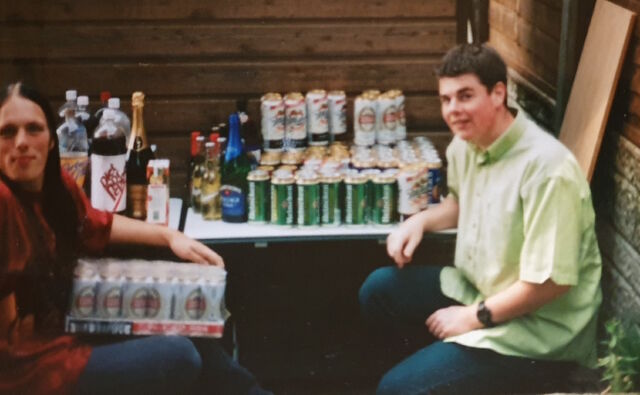
And so when it was announced that a new denomination of coin – the £2 coin – would enter general circulation3 I was pleased to announce how sporting it was of the government to release a “beer token”.
With the average pint of beer at the time costing around £1.90 and a still cash-dominated economy, the “beer token” was perfect! And in my case, it lasted: the bars I was drinking at in the late 1990s were in the impoverished North, and were soon replaced with studenty bars on the West coast of Wales, both of which allowed the price of a pint to do battle with inflationary forces for longer than might have been expected elsewhere in the country. The “beer token” that was the £2 coin was a joke that kept on giving for some time.

As the cost of living rapidly increased circa 2023, the average price of a pint of beer in the UK finally got to the point where, rounded to the nearest whole pound, it was closer to £5 than it is to £44.
And while we could moan and complain about how much things cost nowadays, I’d prefer to see this as an opportunity. An opportunity for a new beer token: a general-release of the £5 coin. We already some defined characteristics that fit: a large, heavy coin, about twice the weight of the £2 coin, with a copper/nickel lustre and struck from engravings with thick, clear lines.
And the design basically comes up with itself. I give you… the Beer Token of the 2020s:

It’s time for the beer token to return, in the form of the £5 coin. Now is the time… now is the last time, probably… before cash becomes such a rarity that little thought is evermore given to the intersection of its design and utility. And compared to a coin that celebrates industry while simultaneously representing a disfunctional machine, this is a coin that Brits could actually be proud of. It’s a coin that tourists would love to take home with them, creating a satisfying new level of demand for the sinking British Pound that might, just might, prop up the economy a little, just as here at home they support those who prop up the bar.
I know there must be a politician out there who’s ready to stand up and call for this new coin. My only fear is that it’s Nigel Fucking Farage… at which point I’d be morally compelled to reject my own proposal.
But for now, I think I’ll have another drink.
1 The recession of the 1970s brought high inflation that caused the price of beer to rocket, pretty much tripling in price over the course of the decade. Probably Douglas Adams didn’t anticipate that it’d more-than-double again over the course of the 1980s before finally slowing down somewhat… at least until tax changes in 2003 and the aftermath of the 2022 inflation rate spike!
2 We do know that the four packets of peanuts Ford bought later were priced at 7p each, so his tip on that transaction was a massive 1,686%: little wonder the barman suddenly started taking more-seriously Ford’s claims about the imminent end of the world!
3 There were commemorative £2 coins of a monometallic design floating around already, of course, but – being collectible – these weren’t usually found in circulation, so I’m ignoring them.
4 Otherwise known as “two beer tokens”, of course. As in “Bloody hell, 2022, why does a pint of draught cost two beer tokens now?”
Oxford Station. Catching a train to Manchester for a get-together in memory of the Nightline Association, which will sadly be closing this year (although individual Nightlines will doubtless soldier on just as they did before the Association).
Carrying a big ol’ bag of Three Rings swag to give to basically anybody who expresses even the slightest interest. 😅
Three Rings has been supporting Nightlines since before the Nightline Association and nowadays underpins voluntary work by hundreds of other charities including helplines like Samaritans and Childline. Feeling sad that the Nightline Association is going away and looking for a new and rewarding way to volunteer? Come chat to me!
I’ve spent the last week1 in Tulum, on Mexico’s beautiful Yucatan Peninsula, for an Automattic meetup. And as usual for these kinds of work gatherings, it was magical (and, after many recent departures, a welcome opportunity to feel a closer connection to those of us that remain).
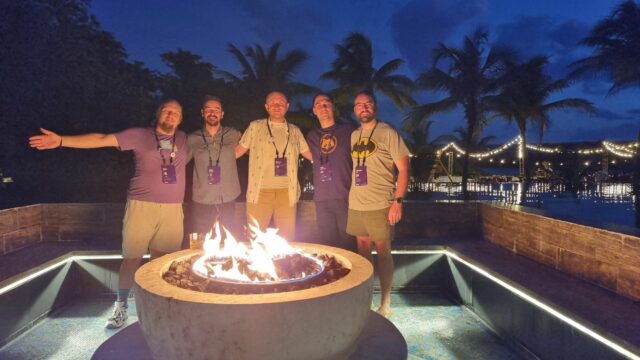
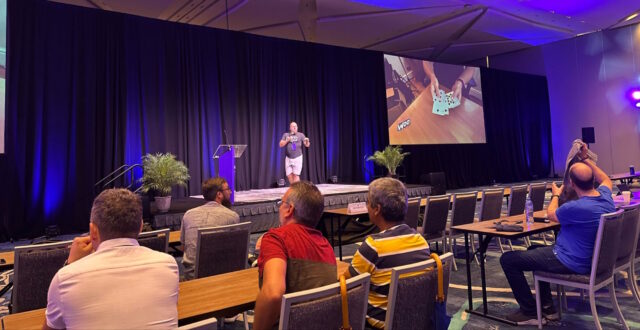
No, I mean that the whole thing felt magical. Like, I’ve discovered, every Automattic meetup I’ve been to has been. But this is perhaps especially true of the larger ones like Vienna last year (where my “flash talk” topic was Finger for WordPress; turns out I love the excuse to listen to other people’s nerdity and fly my own nerd flag a little).

Our events team, who are already some of the most thoughtful and considerate planners you might ever meet, had gone above and beyond in their choice of location. The all-inclusive resort they’d booked out for pretty-much our exclusive use was a little isolated and not the kind of place I’d have chosen for a personal holiday. But it provided all of the facilities my team, sibling teams, and division could desire for work, rest and play.
As usual, an Automattic meetup proved to be a series of long but energising days comprising a mixture of directly work-related events, social team-building and networking opportunities, chances for personal growth and to learn or practice skills, and a sweet sprinkling of fun and memorable activities.

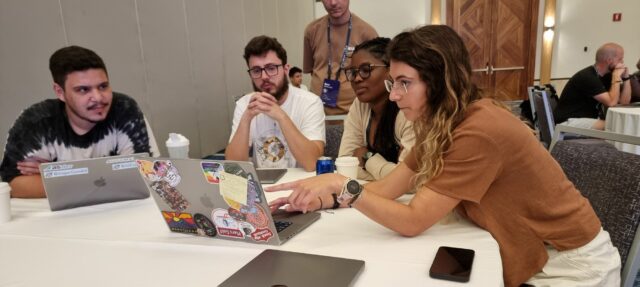
Our meetups might not feel like “work” (even when they clearly are!), but rather like… I don’t know… a holiday with 400 of the coolest, friendliest, most-interesting people you could ever meet6… which just happens to have an overarching theme of something that you love.
Recently-developed changes to strategic priorities, and the departure of a few of our colleagues during the recent aforementioned “realignment”, meant that my “superteam” – my team and its siblings – had a lot to talk about. How can we work better together? How can we best meet the needs of the company while also remaining true to its open-source ideology? What will our relationships with one another and with other parts of the organisation look like in the year to come?
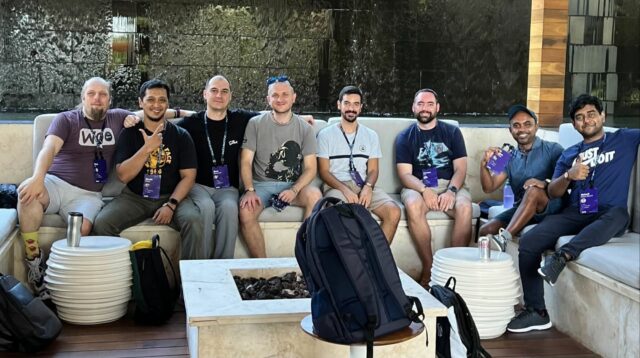
Every morning for a week I’d wake early and walk the soft warm sands and swim in the sea, before meeting with colleagues for breakfast. Then a day of networking and workshops, team-time activities, meetings, and personal development, which gave way to evenings with so much on offer that FOMO was inevitable7.

Our meetups are merely an intense distillation of what makes Automattic magical on a day-to-day basis.

Did I mention that we’re recruiting?
1 Travelling light, as has become my normal.
2 Excluding the two who couldn’t make it in person and the one who’s on parental leave.
3 Another example might be the pronoun pin badges that they made available in various locations, which I’ve written about already.
4 The spiders, which weave long thin strand webs that hang like tinsel from the cave roof, catch and eat mosquitoes, which I’m definitely in favour of.
5 Okay, fine: Harvey Mackey isn’t the original source, and it’s not clear who was.
6 Also, partially-tame trash pandas, which joined iguanas, agouti, sand pipers, and other wildlife around (and sometimes in) our accommodation.
7 I slightly feel like I missed-out by skipping the board gaming, and it sounds like the movie party and the karaoke events were a blast too, but I stand by my choices to drink and dance and perform magic and chat about technology and open source and Star Wars and blogging and music and travel and everything else that I found even the slightest opportunity to connect on with any of the amazing diverse and smart folks with whom I’m fortunate enough to work.
8 While I completely reject the magical thinking espoused by our “sound bath” facilitator, it was still a surprisingly relaxing and meditative experience. It was also a nice chill-out before going off to the higher-energy environment that came next at the poolside bar: drinking cocktails and dancing to the bangin’ tunes being played by our DJ, my colleague Rua.
This weekend I invited over a bunch of our old university buddies, and it was great.
We still didn’t feel up to a repeat of the bigger summer party we held the year before last, but we love our Abnib buddies, so put the call out to say: hey, come on over, bring a tent (or be willing to crash on a sofa bed) if you want to stay over; we’ll let the kids run themselves ragged with a water fight and cricket and football and other garden games, then put them in front of a film or two while we hang out and drink and play board games or something.
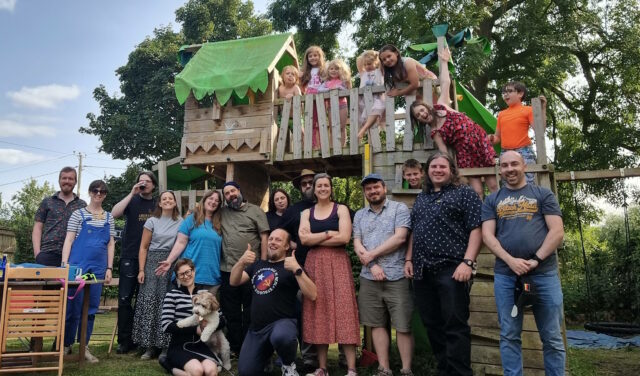
The entire plan was deliberately low-effort. Drinks? We had a local brewery drop us off a couple of kegs, and encouraged people to BYOB. Food? We threw a stack of pre-assembled snacks onto a table, and later in the day I rotated a dozen or so chilled pizzas through the oven. Entertainments? Give the kids a pile of toys and the adults one another’s company.
We didn’t even do more than the bare minimum of tidying up the place before people arrived. Washing-up done? No major trip hazards on the floor? That’s plenty good enough!

I found myself recalling our university days, when low-effort ad-hoc socialising seemed… easy. We lived close together and we had uncomplicated schedules, which combined to make it socially-acceptable to “just turn up” into one another’s lives and spaces. Many were the times that people would descend upon Claire and I’s house in anticipation that there’d probably be a film night later, for example1.
I remember one occasion a couple of decades ago, chilling with friends2. Somebody – possibly Liz – commented that it’d be great if in the years to come our kids would be able to be friends with one another. I was reminded of it when our eldest asked me, of our weekend guests, “why are all of your friends’ children are so great?”
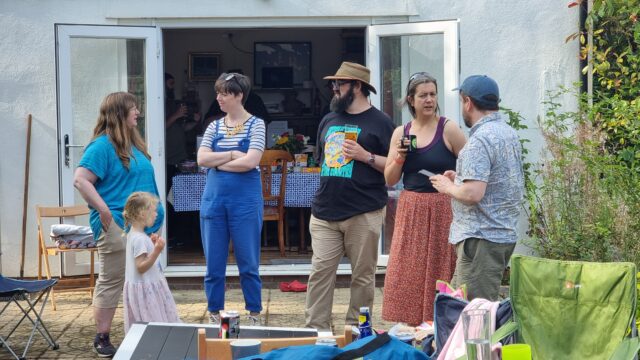
What pleased me in particular was how relatively-effortless it was for us all to slip back into casually spending time together. With a group of folks who have, for the most part, all known each other for over two decades, even not seeing one another in-person for a couple of years didn’t make a significant dent on our ability to find joy in each other’s company.
Plus, being composed of such laid-back folks, it didn’t feel awkward that we had, let’s face it, half-arsed the party. Minimal effort was the order of the day, but the flipside of that was that the value-for-effort coefficient was pretty-well optimised3.
A delightful weekend that I was glad to be part of.
1 That Claire and I hosted so many social events, both regular and unplanned, eventually lead us to the point that it was the kind of thing we considered whenever we moved house!
2 Perhaps at the Ship & Castle, where we spent a reasonable amount of our education.
3 I’m pretty sure that if I’d have used the term “value-for-effort coefficient” at the party, though, then it’d have immediately sucked 100% of the fun out of the room.
Two years after our last murder mystery party, almost three years since the one before, and much, much longer since our last in-person one, we finally managed to have another get-the-guests-in-one-place murder mystery party, just like old times. And it was great!
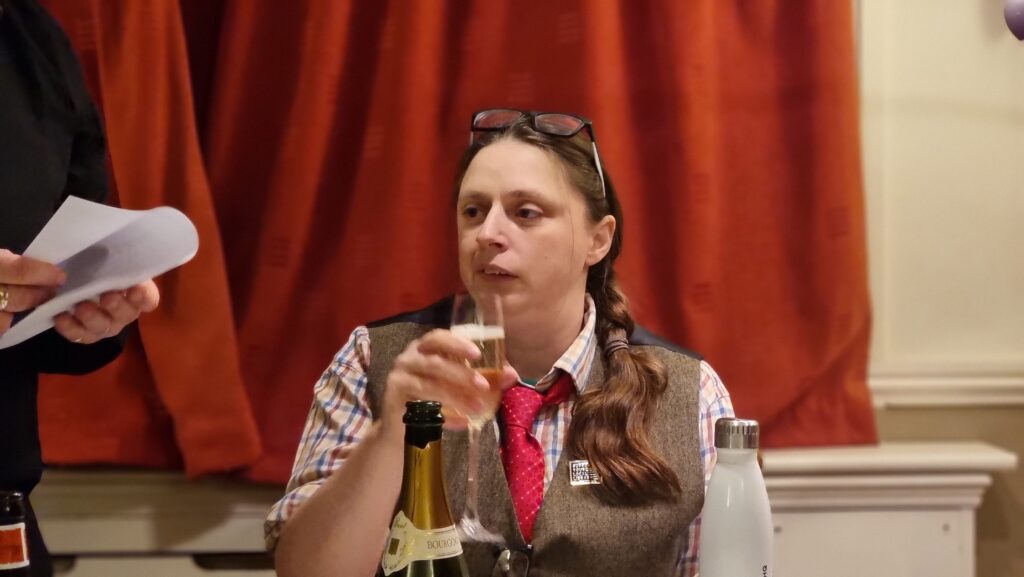
It’s still been been over a decade since we played a mystery that I wrote (though I’m hoping to rectify that within the year): this time we played D’Avekki Studios‘ Murder in the Library.
D’Avekki’s murder mystery sets use an unusual mechanic that I’ve discussed before online with other murder mystery party authorship enthusiasts1 but never tried in practice: a way of determining at random who the murderer is when play begins. This approach has a huge benefit in that it means that you can assign characters to players using a subset of those available (rather than the usual challenges that often come up when, for example, somebody need to play somebody of a different gender than their own) and, more-importantly, it protects you from the eventuality that a player drops-out at short notice. This latter feature proved incredibly useful as we had a total of three of our guests pull out unexpectedly!
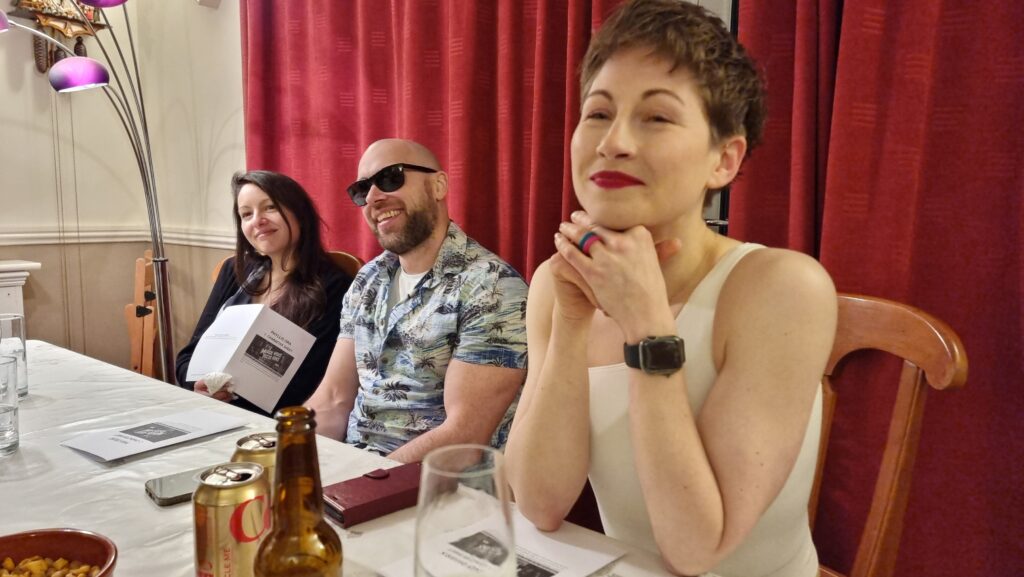
The challenge of writing a murder mystery with such a mechanic is to ensure that the script and evidence adapt to the various possible murderers. When I first examined the set that was delivered to us, I was highly skeptical: the approach is broadly as follows2:
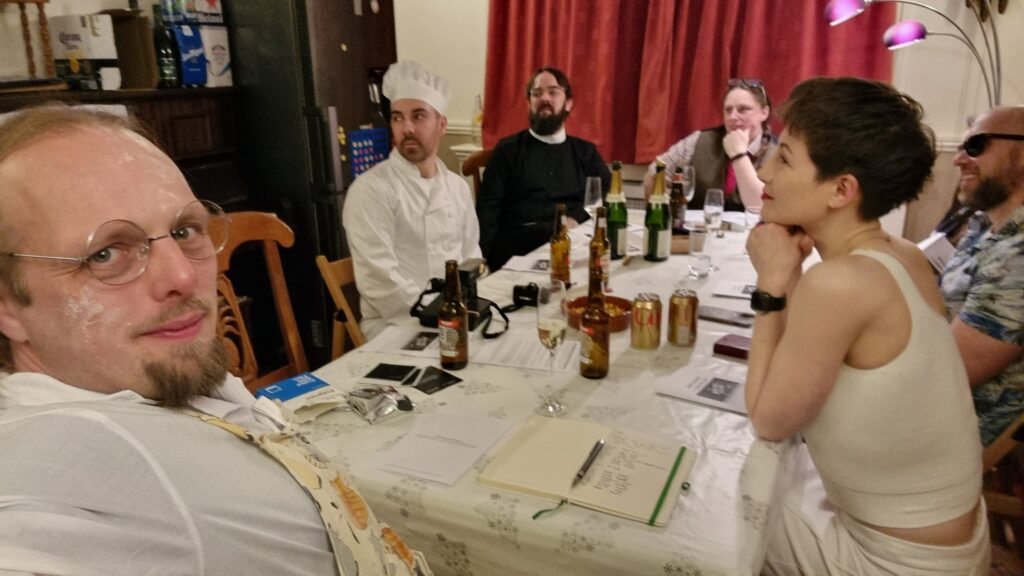
The writing was good overall: I especially appreciated the use of a true crime podcast as a framing device (expertly delivered thanks to Rory‘s radio voice). It was also pleasing to see, in hindsight, how the story had been assembled such that any character could be the murderer, but only one would give away a crucial clue. The downside of the format is pretty obvious, though: knowing what the mechanic is, a detective only needs to look at each piece of evidence that appears and look for a connection with each statement given by every other player, ruling out any “red herring” pairings that connect to every other player (as is common with just about the entire genre, all of the suspects had viable motives: only means and opportunity may vary).
It worked very well, but I wonder if – now the formula’s understood by us – a second set in a similar style wouldn’t be as successful.
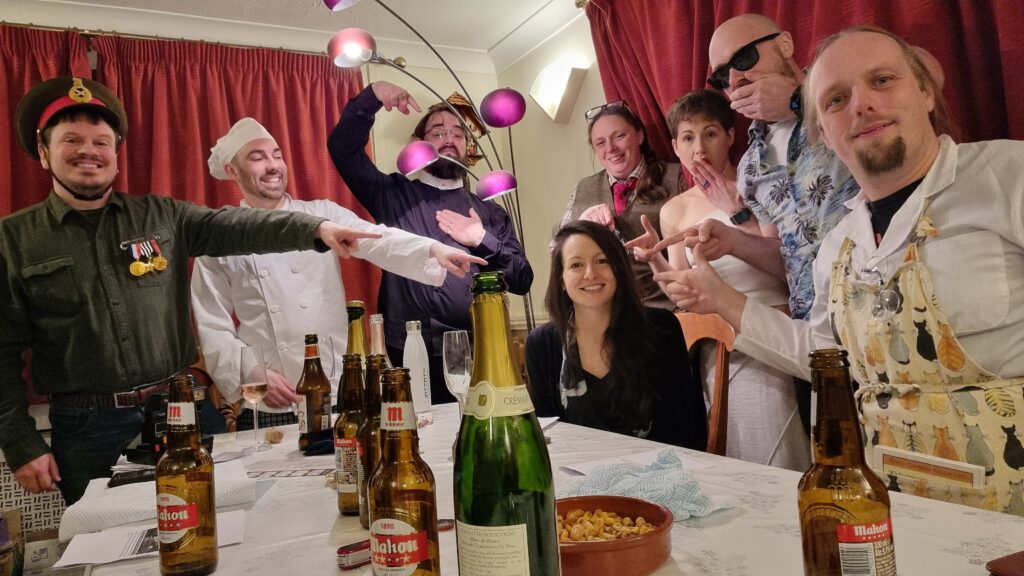
That said, nobody correctly fingered the murderer this time around. Maybe we’re out of practice? Or maybe the quality of the hints in such a wide-open and dynamic murderer-selection mechanic is less-solid than we’re used to? It’s hard to say: I’d certainly give another D’Avekki a go to find out.
A love a good Jackbox Game. There’s nothing quite like sitting around the living room playing Drawful, Champ’d Up, Job Job, Trivia Murder Party, or Patently Stupid. But nowadays getting together in the same place isn’t as easy as it used to be, and as often as not I find my Jackbox gaming with friends or coworkers takes place over Zoom, Around, Google Meet or Discord.
There’s lots of guides to doing this – even an official one! – but they all miss a few pro tips that I think can turn a good party into a great party. Get all of this set up before your guests are due to arrive to make yourself look like a super-prepared digital party master.

Using one computer for your video call and a second one to host the game (in addition to the device you’re using to play the games, which could be your phone) is really helpful for several reasons:
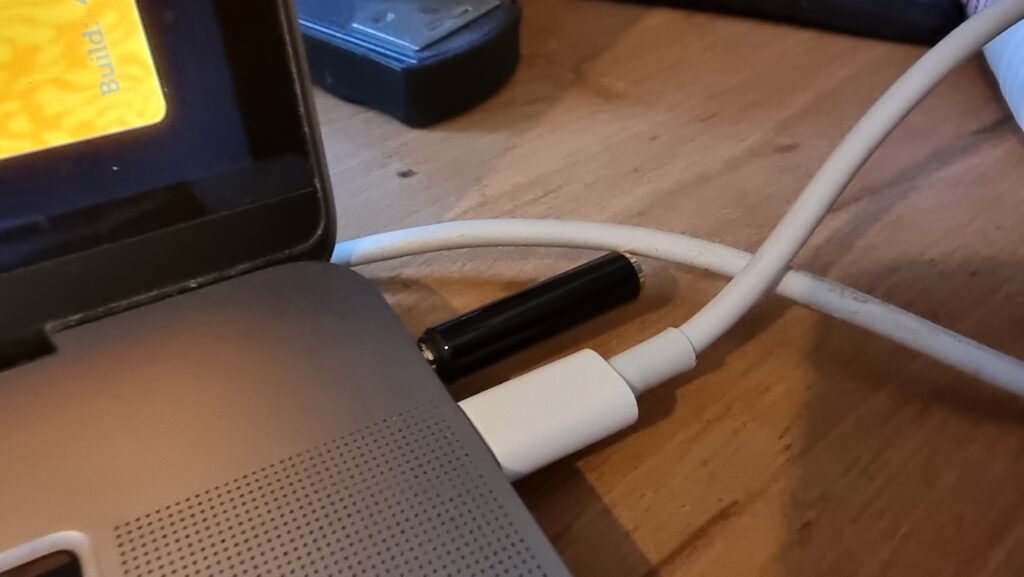
Connect some headphones to the computer that’s running the game (or set up a virtual audio output device if you’re feeling more technical). This means you can still have the game play sounds and transmit them over Zoom, but you’ll only hear the sounds that come through the screen share, not the sounds that come through the second computer too.
That’s helpful, because (a) it means you don’t get feedback or have to put up with an echo at your end, and (b) it means you’ll be hearing the game exactly the same as your guests hear it, allowing you to easily tweak the volume to a level that allows for conversation over it.
Jackbox games were designed first and foremost for sofa gaming, and playing with friends over the Internet benefits from a couple of changes to the default settings.
Sometimes the settings can be found in the main menu of a party pack, and sometimes they’re buried in the game itself, so do your research and know your way around before your party starts.
Turn the volume down, especially the volume of the music, so you can have a conversation over the game. I’d also recommend disabling Full-screen Mode: this reduces the resolution of the game, meaning there’s less data for your video-conferencing software to stream, and makes it easier to set up screen sharing without switching back and forth between your applications (see below).
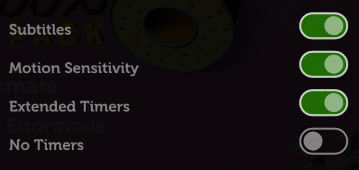
Turning on the Motion Sensitivity or Reduce Background Animations option if your game has it means there’ll be less movement in the background of the game. This can really help with the
video compression used in videoconferencing software, meaning players on lower-speed connections are less-likely to experience lag or “blockiness” in busy scenes.
It’s worth considering turning Subtitles on so that guests can work out what word they missed (which for the trivia games can be a big deal). Depending on your group, Extended Timers is worth considering too: the lag introduced by videoconferencing can frustrate players who submit answers at the last second only to discover that – after transmission delays – they missed the window! Extended Timers don’t solve that, but they do mean that such players are less-likely to end up waiting to the last second in the first place.
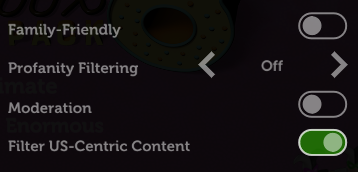
Finally: unless the vast majority or all of your guests are in the USA, you might like to flip the Filter US-Centric Content
switch so that you don’t get a bunch of people scratching their heads over a cultural reference that they just don’t get.
By the way, you can use your cursor keys and enter to operate Jackbox games menus, which is usually easier than fiddling with a mouse.
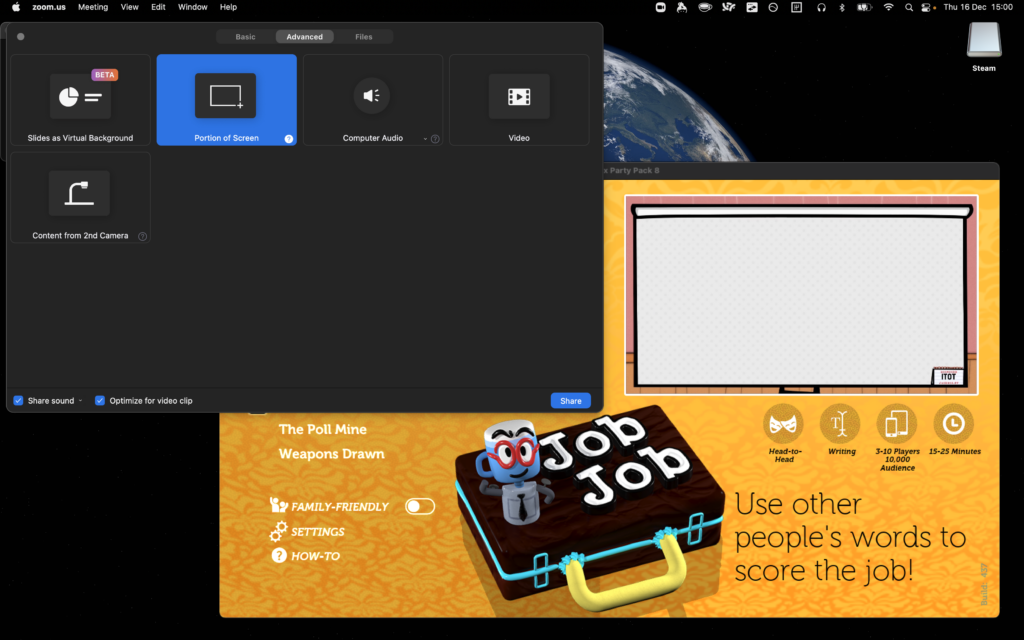
Whatever videoconferencing platform you’re using, the settings for screen sharing are usually broadly similar. I suggest:
Don’t forget to shut down any software that might “pop up” notifications: chat applications, your email client, etc.: the last thing you want is somebody to send you a naughty picture over WhatsApp and the desktop client to show it to everybody else in your party!
On account of the pandemic, I’d expected my fortieth birthday to be a somewhat more-muted affair than I’d hoped. I had a banner, I got trolled by bagels, and I received as a gift a pizza oven with which I immediately set fire to several pieces of cookware, but I hadn’t expected to be able to do anything like the “surprise” party of my thirtieth, and that saddened me a little. So imagine my surprise when I come back from an evening walk the day after my birthday to discover than an actual (remote) surprise party really had been arranged without my knowing!
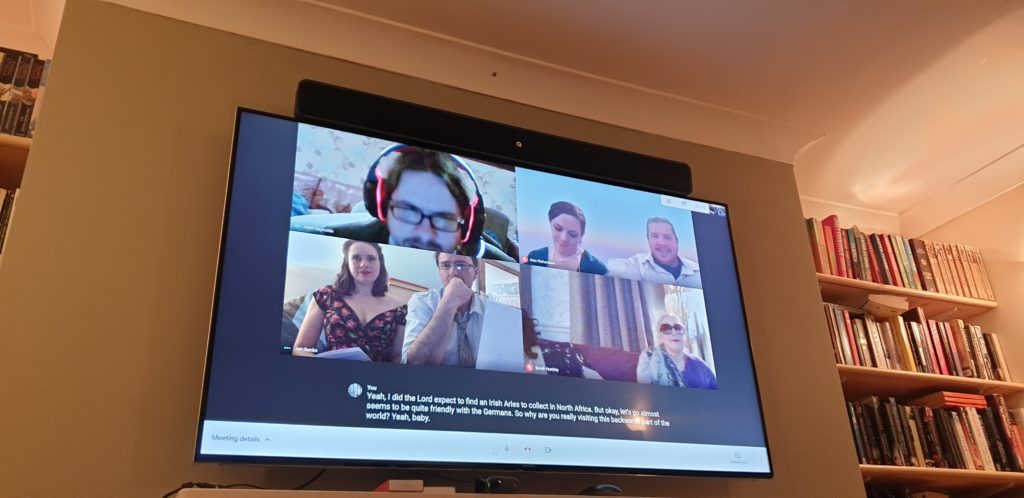
Not content with merely getting a few folks together for drinks, though, Ruth and team had gone to great trouble (involving lots of use of the postal service) arranging a “kit” murder mystery party in the Inspector McClue series – The Diamonds, The Dagger, and One Classy Dame – for us all to play. The story is sort-of a spiritual successor to The Brie, The Bullet, and The Black Cat, which we’d played fifteen years earlier. Minor spoilers follow.

Naturally, I immediately felt underdressed, having not been instructed that I might need a costume, and underprepared, having only just heard for the first time that I would be playing the part of German security sidekick Lieutenant Kurt Von Strohm minutes before I had to attempt my most outrageous German accent.

The plot gave me in particular a certain sense of deja vu. In The Brie, The Bullet, and The Black Cat, I played a French nightclub owner who later turned out to be an English secret agent supplying the French Resistance with information. But in The Diamonds, The Dagger, and One Classy Dame I played a Gestapo officer who… also later turned out to be an English secret agent infiltrating the regime and, you guessed it, supplying the French Resistance.

It was not the smoothest nor the most-sophisticated “kit” murder mystery we’ve enjoyed. The technology made communication challenging, the reveal was less-satisfying than some others etc. But the company was excellent. (And the acting way pretty good too, especially by our murderer whose character was exquisitely played.)

And of course the whole thing quickly descended into a delightful shouting match with accusations flying left, right, and centre and nobody having a clue what was going on. Like all of our murder mystery parties!

In summary, the weekend of my fortieth birthday was made immeasurably better by getting to hang out with (and play a stupid game with) some of my friends despite the lockdown, and I’m ever so grateful that those closest to me were able to make such a thing happen (and without me even noticing in advance).
This weekend I announced and then hosted Homa Night II, an effort to use technology to help bridge the chasms that’ve formed between my diaspora of friends as a result mostly of COVID. To a lesser extent we’ve been made to feel distant from one another for a while as a result of our very diverse locations and lifestyles, but the resulting isolation was certainly compounded by lockdowns and quarantines.

Back in the day we used to have a regular weekly film night called Troma Night, named after the studio who dominated our early events and whose… genre… influenced many of our choices thereafter. We had over 300 such film nights, by my count, before I eventually left our shared hometown of Aberystwyth ten years ago. I wasn’t the last one of the Troma Night regulars to leave town, but more left before me than after.

Earlier this year I hosted Sour Grapes, a murder mystery party (an irregular highlight of our Aberystwyth social calendar, with thanks to Ruth) run entirely online using a mixture of video chat and “second screen” technologies. In some ways that could be seen as the predecessor to Homa Night, although I’d come up with most of the underlying technology to make Homa Night possible on a whim much earlier in the year!

How best to make such a thing happen? When I first started thinking about it, during the first of the UK’s lockdowns, I considered a few options:
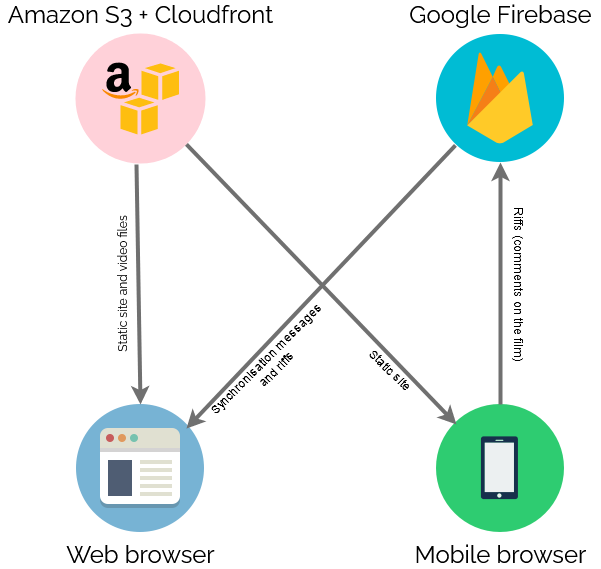
So obviously I ended up implementing my own streaming service. It wasn’t even that hard. In case you want to try your own, here’s how I did it:
First, I used Adobe Premiere to create a video file containing both of the night’s films, bookended and separated by “filler” content to provide an introduction/lobby, an intermission, and a closing “you should have stopped watching by now” message. I made sure that the “intro” was a nice round duration (90s) and suitable for looping because I planned to hold people there until we were all ready to start the film. Thanks to Boris & Oliver for the background music!

Next, I ran the output through Handbrake to produce “web optimized” versions in 1080p and 720p output sizes. “Web optimized” in this case means that metadata gets added to the start of the file to allow it to start playing without downloading the entire file (streaming) and to allow the calculation of what-part-of-the-file corresponds to what-part-of-the-timeline: the latter, when coupled with a suitable webserver, allows browsers to “skip” to any point in the video without having to watch the intervening part. Naturally I’m encoding with H.264 for the widest possible compatibility.
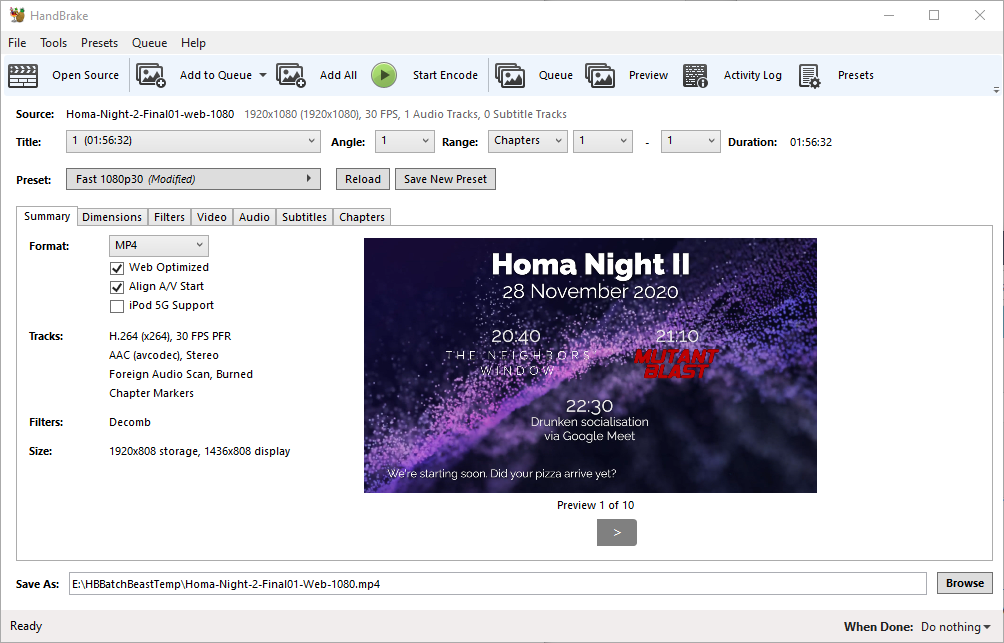
To keep everybody’s viewing experience in-sync, I set up a Firebase account for the application: Firebase provides an easy-to-use Websockets
platform with built-in data synchronisation. Ignoring the authentication and chat features, there wasn’t much
shared here: just the currentTime of the video in seconds, whether or not introMode was engaged (i.e. everybody should loop the first 90 seconds, for now), and
whether or not the video was paused:
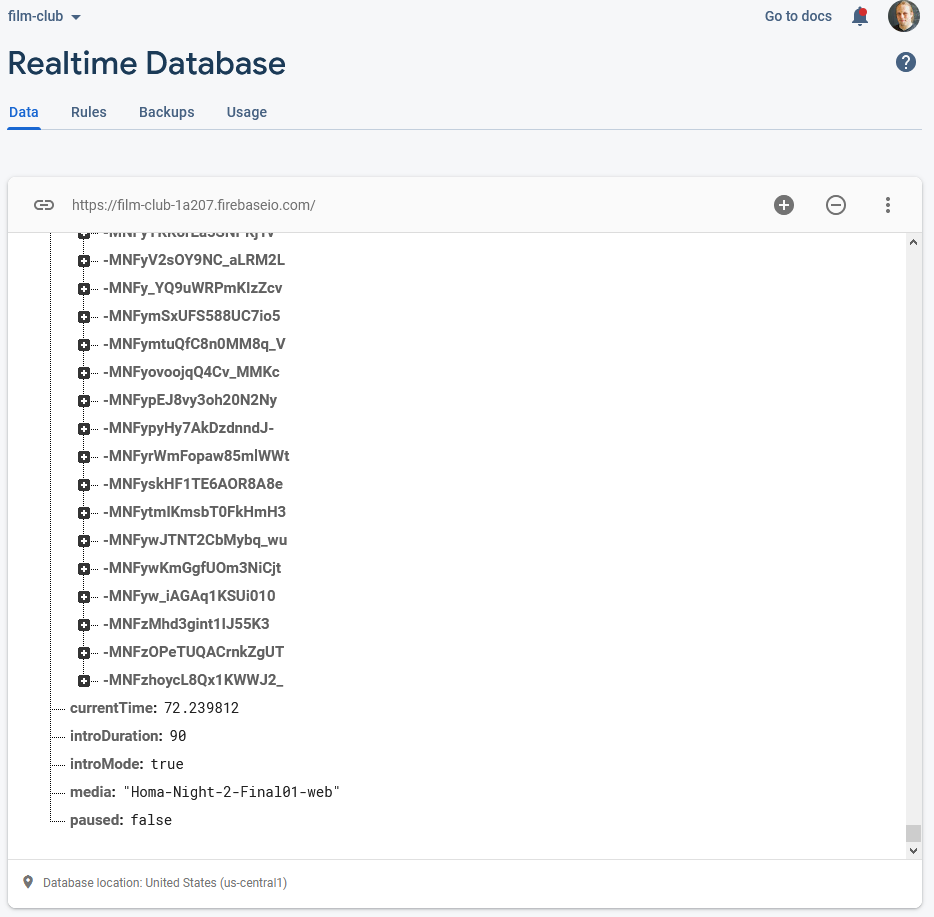
To reduce development effort, I never got around to implementing an administrative front-end; I just manually went into the Firebase database and acknowledged “my” computer as being an
administrator, after I’d connected to it, and then ran a little Javascript in my browser’s debugger to tell it to start pushing my video’s currentTime to the server every
few seconds. Anything else I needed to edit I just edited directly from the Firebase interface.
Other web clients’ had Javascript to instruct them to monitor these variables from the Firebase database and, if they were desynchronised by more than 5 seconds, “jump” to the correct point in the video file. The hard part of the code… wasn’t really that hard:
// Rewind if we're passed the end of the intro loop function introModeLoopCheck() { if (!introMode) return; if (video.currentTime > introDuration) video.currentTime = 0; } function fixPlayStatus() { // Handle "intro loop" mode if (remotelyControlled && introMode) { if (video.paused) video.play(); // always play introModeLoopCheck(); return; // don't look at the rest } // Fix current time const desync = Math.abs(lastCurrentTime - video.currentTime); if ( (video.paused && desync > DESYNC_TOLERANCE_WHEN_PAUSED) || (!video.paused && desync > DESYNC_TOLERANCE_WHEN_PLAYING) ) { video.currentTime = lastCurrentTime; } // Fix play status if (remotelyControlled) { if (lastPaused && !video.paused) { video.pause(); } else if (!lastPaused && video.paused) { video.play(); } } // Show/hide paused notification updatePausedNotification(); }
Finally, there needed to be a web page everybody could go to to get access to this. As I was hosting the video on S3+CloudFront anyway, I put the HTML/CSS/JS there too.

I tested in Firefox, Edge, Chrome, and Safari on desktop, and (slightly less) on Firefox, Chrome and Safari on mobile. There were a few quirks to work around, mostly to do with browsers not letting videos make sound until the page has been interacted with after the video element has been rendered, which I carefully worked-around by putting a popup “over” the video to “enable sync”, but mostly it “just worked”.
On the night I shared the web address and we kicked off! There were a few hiccups as some people’s browsers got disconnected early on and tried to start playing the film before it was time, and one of these even when fixed ran about a minute behind the others, leading to minor spoilers leaking via the rest of us riffing about them! But on the whole, it worked. I’ve had lots of useful feedback to improve on it for the next version, and I might even try to tidy up my code a bit and open-source the results if this kind of thing might be useful to anybody else.
It had been a long while since our last murder mystery party: we’ve only done one or two “kit” ones since we moved in to our current house in 2013, and we’re long-overdue a homegrown one (who can forget the joy of Murder at the Magic College?), but in the meantime – and until I have the time and energy to write another one of my own – we thought we’d host another.
But how? Courtesy of the COVID-19 crisis and its lockdown, none of our friends could come to visit. Technology to the rescue!
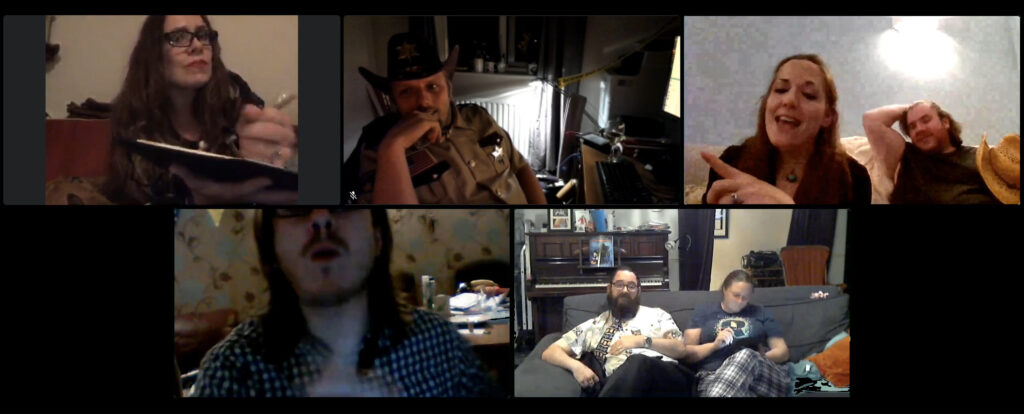
I took a copy of Michael Akers‘ murder mystery party plan, Sour Grapes of Wrath, and used it as the basis for Sour Grapes, a digitally-enhanced (and generally-tweaked) version of the same story, and recruited Ruth, JTA, Jen, Matt R, Alec and Suz to perform the parts. Given that I’d had to adapt the materials to make them suitable for our use I had to assign myself a non-suspect part and so I created police officer (investigating the murder) whose narration provided a framing device for the scenes.

I threw together a quick Firebase backend to allow data to be synchronised across a web application, then wrote a couple of dozen lines of Javascript to tie it together. The idea was that I’d “push” documents to each participants’ phone as they needed them, in a digital analogue of the “open envelope #3” or “turn to the next page in your book” mechanism common in most murder mystery kits. I also reimplemented all of Akers’ artefacts, which were pretty-much text-only, as graphics, and set up a system whereby I could give the “finder” of each clue a copy in-advance and then share it with the rest of the participants when it was appropriate, e.g. when they said, out loud “I’ve found this newspaper clipping that seems to say…”
The party itself took place over Discord video chat, with which I’d recently had a good experience in an experimental/offshoot Abnib group (separate from our normal WhatsApp space) and my semi-associated Dungeons & Dragons group. There were a few technical hiccups, but only what you’d expect.
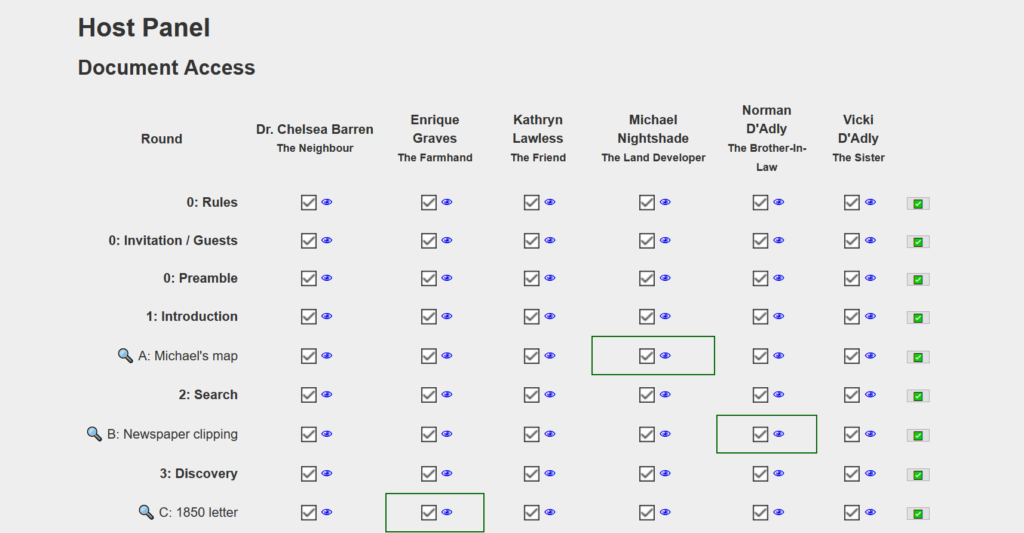
The party itself rapidly descended into the usual level of chaos. Lots of blame thrown, lots of getting completely off-topic and getting distracted solving the wrong puzzles, lots of discussion about the legitimacy of one of several red herrings, and so on. Michael Akers makes several choices in his writing that don’t appear in mine – such as not revealing the identity of the murderer even to the murderer until the final statements – which I’m not a fan of but retained for the sake of honouring the original text, but if I were to run a similar party again I’d adapt this, as I had a few other aspects of the setting and characters. I think it leads to a more fun game if, in the final act, the murderer knows that they committed the crime, that all of the lies they’ve already told are part of their alibi-building, and they’re given carte blanche to lie as much as they like in an effort to “get away with it” from then on.

Of course, Ruth felt the need to cater for the event – as she’s always done with spectacular effect at every previous murder mystery she’s hosted or we’ve collectively hosted – despite the distributed partygoers. And so she’d arranged for a “care package” of wine and cheese to be sent to each household. The former was, as always, an excellent source of social lubrication among people expected to start roleplaying a random character on short notice; the latter a delightful source of snacking as we all enjoyed the closest thing we’ll get to a “night out” in many months.
This was highly experimental, and there are lessons-for-myself I’d take away from it:
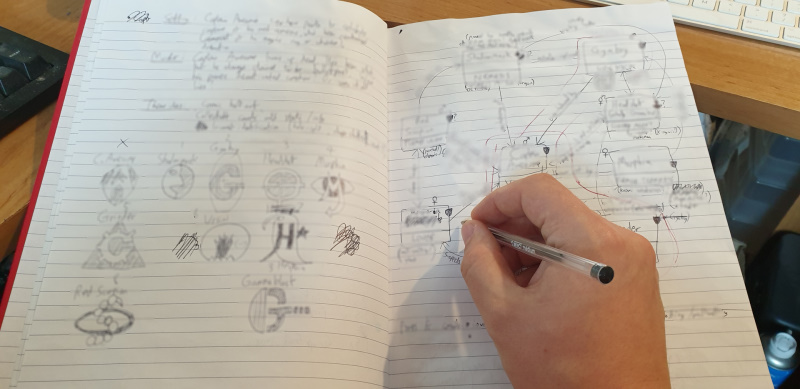
Meanwhile: if you want to see some moments from Sour Grapes, there’s a mini YouTube playlist I might get around to adding to at some point. Here’s a starter if you’re interested in what we got up to (with apologies for the audio echo, which was caused by a problem with the recording software):
Eight years, six months, and one week after I started at the Bodleian, we’ve gone our separate ways. It’s genuinely been the nicest place I’ve ever worked; the Communications team are a tightly-knit, supportive, caring bunch of diverse misfits and I love them all dearly, but the time had come for me to seek my next challenge.
(For anybody out-of-the-loop, I’m moving to Automattic after surviving their amazing, mind-expanding recruitment process).
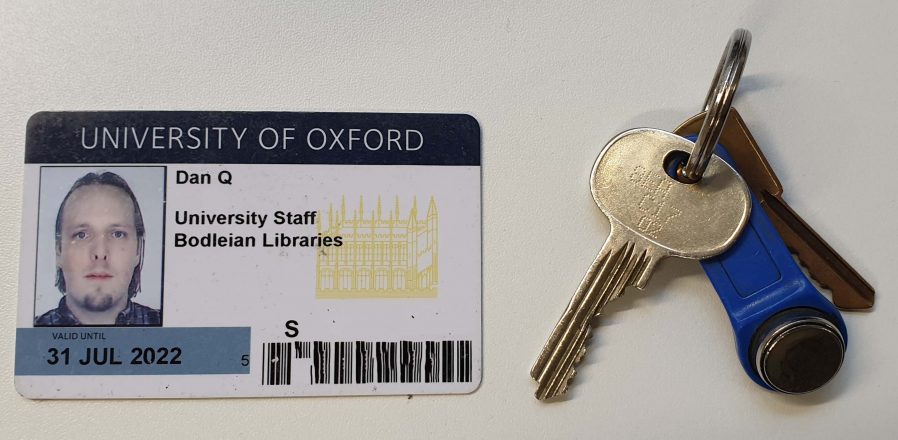
Being awesome as they are, my team threw a going-away party for me, complete with food from Najar’s Place, about which I’d previously raved as having Oxford’s best falafels. I wasn’t even aware that Najar’s place did corporate catering… actually, it’s possible that they don’t and this was just a (very) special one-off.
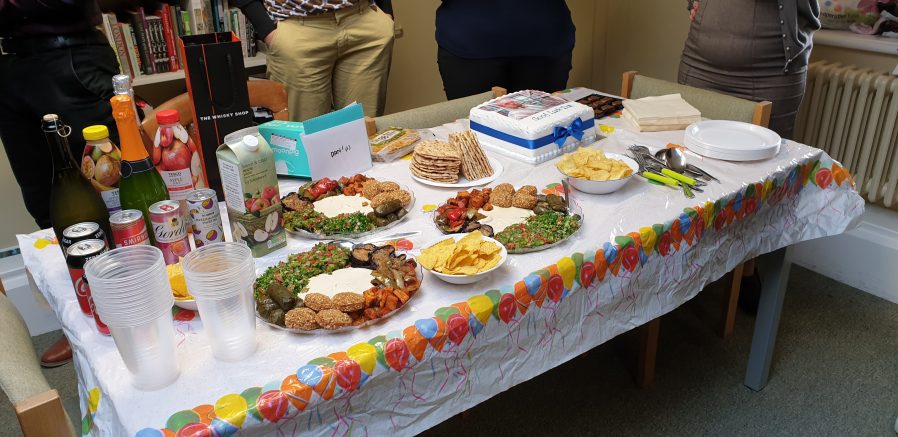
Following in the footsteps of recent team parties, they’d even gotten a suitably-printed cake with a picture of my face on it. Which meant that I could leave my former team with one final magic trick, the never-before-seen feat of eating my own head (albeit in icing form).
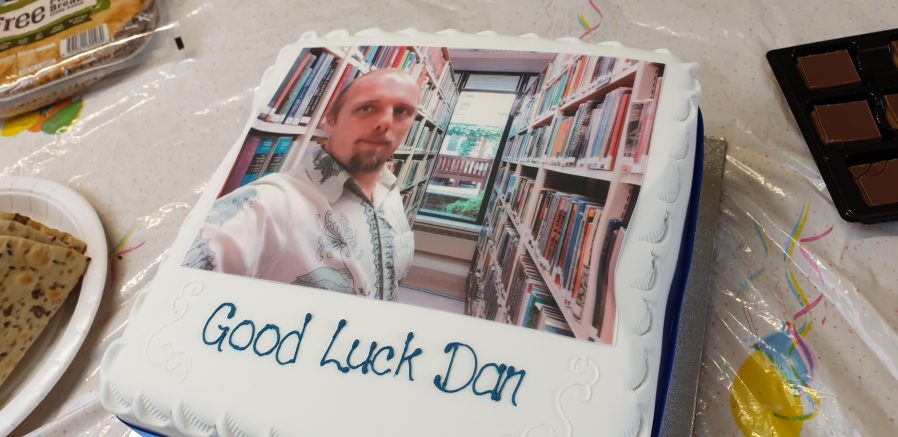
As the alcohol started to work, I announced an activity I’d planned: over the weeks prior I’d worked to complete but not cash-in reward cards at many of my favourite Oxford eateries and cafes, and so I was now carrying a number of tokens for free burritos, coffees, ice creams, smoothies, pasta and more. Given that I now expect to spend much less of my time in the city centre I’d decided to give these away to people who were able to answer challenge questions presented – where else? – on our digital signage simulator.
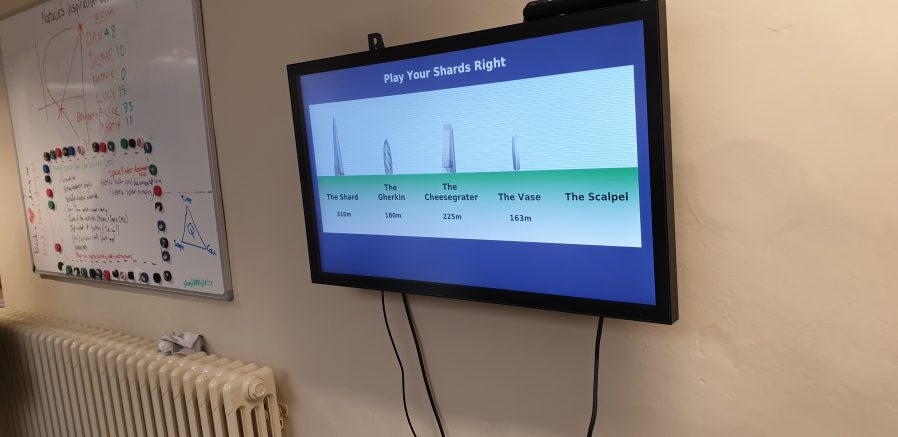
I also received some wonderful going-away gifts, along with cards in which a few colleagues had replicated my long tradition of drawing cartoon animals in other people’s cards, by providing me with a few in return.
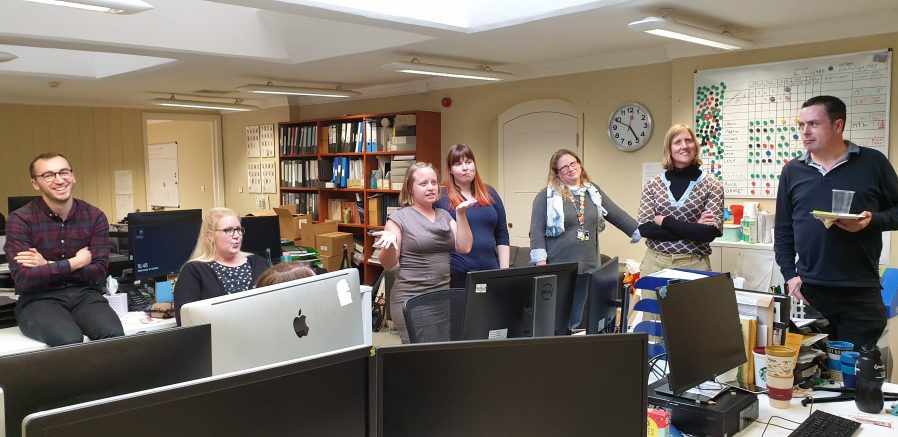
Later, across the road at the Kings’ Arms and with even more drinks inside of me, I broke out the lyrics I’d half-written to a rap song about my time at the Bodleian. Because, as I said at the time, there’s nothing more-Oxford than a privileged white boy rapping about how much he’d loved his job at a library (video also available on QTube [with lyrics] and on Videopress).
It’s been an incredible 8½ years that I’ll always look back on with fondness. Don’t be strangers, guys!
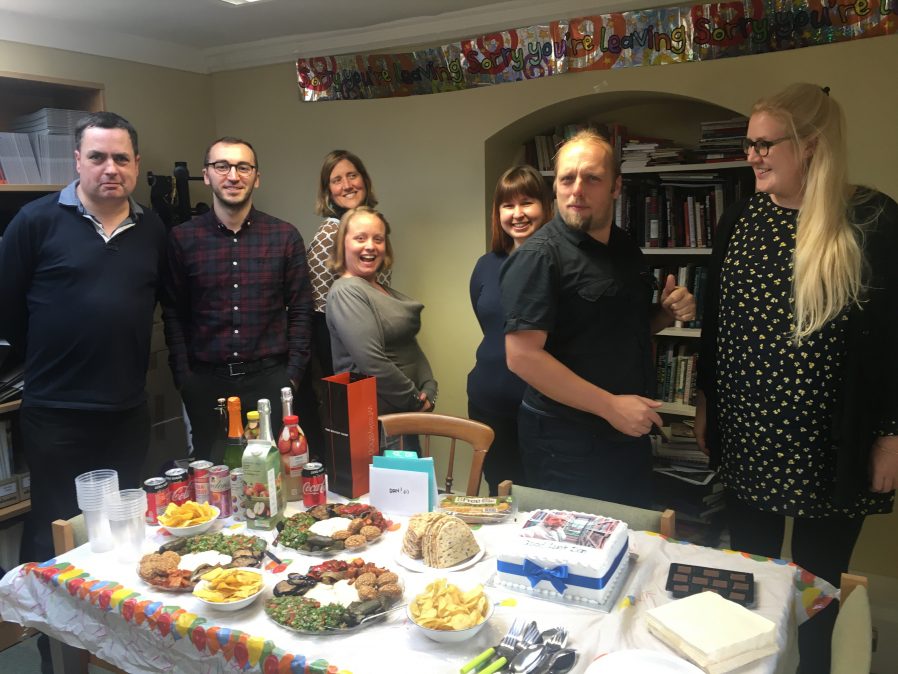
Short version of the review: a few teething problems aside, we all had a wonderful time and we’d certainly consider a Daggerville game for our next murder mystery party. The characters were, on the whole, wonderful characters well-realised and fully-developed within the constraints of the genre, the twist was clever, there were moments of great hilarity (such as the point when we realised that there’d been a veritable conga-line of people stealthily following one another around the hotel), and the event built up to a fun and satisfying conclusion. I’d suggest that you all keep an eye on Daggerville in the future.
As implied earlier this week, this weekend Ruth, JTA and I had planned to host the latest in a long series of murder mystery party nights (a handful of which have been reviewed on this blog). Despite our earlier worries, we eventually filled the “missing” slots in our party with our friends Liz and Dean: exactly the couple we’d planned to fill it with in the first place, but they’d been painfully slow at RSVPing.
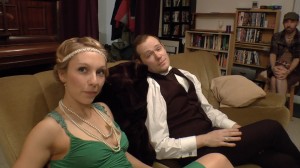
We’ve played a lot of murder mystery games over the years: we could probably be described as connoisseurs of the genre, and that might be worth bearing in mind when you read what we had to say about this particular event. To enumerate, there’s been:
That said, this latest party really had the opportunity to cross the board, with Liz and Dean having never been to a murder mystery night before and (other) Liz and Simon having been to only a few. And to top it all off, we were working with a completely new game from a creator of whom we’d had no experience. What could be more exciting?
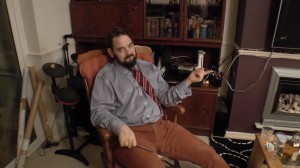
You see: I was contacted a little over two months ago, via my web form, by a Martin from Daggerville Games, a new murder mystery party provider of the “buy-and-download” variety. Upon visiting their website, I was immediately struck by some of the similarities between their signup form (which asks for player names to be associated with characters, genders to be chosen for characters whose gender can be selected based on the gender balance among the players, and email addresses to which invitations will be sent) and a prototype one of my own design, used in the construction of my upcoming games Murder at the Glam Rock Concert and Murder on the Social Network, the first of which we hope to host in about a year’s time. I mentioned this to Martin, in the hope that they won’t think I’m ripping them off if I eventually put some of my pieces online for the world to play, too.
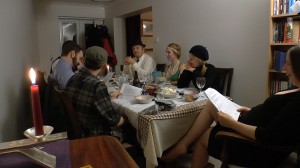
The Daggerville folks, perhaps anticipating that I would be likely to blog about the event in hindsight and thus provide them with some free publicity, offered me a voucher for a free game of my choice, which I accepted. After a little discussion, we settled upon The Ambassador’s Notebook, a 7-player murder mystery set in a rural 1920s hotel and revolving around the untimely death of a Mr. Sullivan, presumably related to a valuable journal that was in his possession.

In order to keep the spoilers at the tail end of this blog post (there’ll be a nice big warning before you get to them, so you can refrain from reading them if you’re planning to someday play this game yourself), I’ll cut to the chase and first provide a summary of the night as a whole.
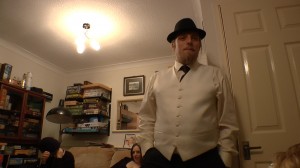
We all had a fun time: as usual for these gatherings, there was good wine, great company, and spectacular food (Ruth had, once again, put together a wonderfully thought-out and
thematically-sound menu): honestly, under these conditions we’d be pretty-much guaranteed a good night no matter what. The murder mystery itself was a scripted affair similar to those
you’ll find in any off-the-shelf kit, but with a few quirks. For a start, as hinted above, everybody gets their fragments of the script (along with dialogue entry and exit cues) very
early on: it’s possible, permitted, and even encouraged that players read their script before they arrive for the event. Some of us were concerned that this might result in
“spoilers”, and a few of those of us who did pre-read our scripts said that they regretted doing so, so be aware: it’s a spoiler-risk.
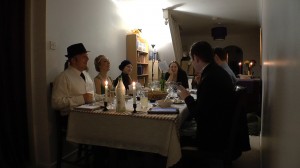
Unlike similar-styled games, though, players aren’t given additional information outside of the script, and we all felt that this made things challenging when it came to the discussion breaks. All that we had to go on for our deliberations was exactly what we’d all heard, just minutes before, tempered by our own speculation. Sometimes somebody would ask, or consider asking, a valid question after somebody’s whereabouts, alibi, or history, but no answer was forthcoming because all that we had, collectively, was the script. This caused additional confusion when, for example, Liz’s character mentioned JTA’s character by his first name, it was a surprise to everybody… even JTA, who had no idea to begin with that it was supposed to be his name!
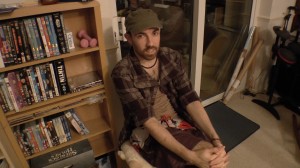
None of the problems we experienced “broke” the game, and we found our way to a reasonably-satisfactory conclusion. A majority of us voted correctly, determining the identity of the murderer, and Ruth even managed to identify an important twist (albeit not based on anything more than speculation: the “flash” was a little subtle for us). There were a few anachronisms in the script, but they’re of the kind that only nerds like us would notice (the National Theatre is mentioned despite the fact that it won’t be founded for another four decades or so, and a character makes a reference to a frozen turkey, even though freezing of meat in the West wasn’t yet commonplace, for example). We’d have really liked to have each had a brief – even just half a page! – to tell us each more about our own characters (their names, for example, as well some of the secrets that they might be concealing and any established relationships they have with other characters), and if we knew that Daggerville were adding this feature, it’d make us far more-likely to buy their products in future.
The short review would be: a few teething problems aside, we all had a wonderful time and we’d certainly consider a Daggerville game for our next murder mystery party. The characters were, on the whole, wonderful characters well-realised and fully-developed within the constraints of the genre, the twist was clever, there were moments of great hilarity (such as the point when we realised that there’d been a veritable conga-line of people stealthily following one another around the hotel), and the event built up to a fun and satisfying conclusion. I’d suggest that you all keep an eye on Daggerville in the future.
[spb_message color=”alert-warning” width=”1/1″ el_position=”first last”]Spoiler warning: reading beyond here could result in seeing spoilers. Don’t read on if you’re likely to ever take part in a game of The Ambassador’s Notebook.[/spb_message]
Aside from the lack of character “introductions”, another thing we found difficult in this game were issues in the script. The script for “The Neighbour” ended up one-number out of sync in the middle of Scene 2, where her ‘line 42’ indicated that a different person should be talking to what the rest of the scripts said. On another occasion, the script for “The Proprietress” seemed to be missing a line (although other characters had the ‘tail end’ of that line). The character of “The Journalist” can be played by a man or a woman, and although I selected “male” when I filled in the form, some of the scripts referred to the character as a woman! At first I thought that this might be related to difficulties some of us had had receiving the emailed scripts (Martin at Daggerville was incredibly helpful at sending out fresh ones, though), but we found at least one instance in which one person flip-flopped between referring to “The Journalist” as female or male!
(there’s a video I’ve put together of some of the highlights of our evening, but there’s possible spoilers in it)

Personally, though, my favourite moment of the night came right at the start, as we all introduced our characters. One of the Liz’s, an American, had decided to play her character as an American, and introduced herself as such. “Oh,” said the other Liz, whom she’d just met, “Are you going to do an accent?”
We’re hoping to have a mini-murder mystery this Saturday, 2nd November, in Oxford, and after a
series of people who can’t make it, we’re in need of two people to come along and play. If you want to come then, basically, you’re in, and we’d love to have you.

We’re looking for either two women or a man and a woman, but even if you haven’t got a “date” to bring, if you can make it then let us know and we’ll try to find somebody to fill the other gap. Just leave a comment and I’ll get back to you soon!
This blog post is the third in a series about buying our first house. In the third post, Ruth, JTA and I had acquired some lawyers and started the conveyancing process…
We’re moving house! And we want your help!
There’ve been… a few hitches with the house move. A few little hurdles. And then a few big hurdles. It’s been a little challenging, is what I’m trying to say. I’ll write about that in Part 5, but for now: we need your help!
(cynical folks might notice that pizza, booze, rental vans and friends are a lot cheaper than professional removals companies, especially for short hops across to the other side of a city)
Can you help? Can you be free for some or all of the weekend of 27th & 28th of July, to come and shift boxes in exchange for good times, booze and snacks? If you are, we’d love to have you over. Ruth has written more about the wonderful perks that you’ll enjoy if you can help us, so – if you’re free and can get to Oxford – please come! And it’ll be lovely to see you, too!
You know how when your life is busy time seems to creep by so slowly… you look back and say “do you remember the time… oh, that was just last week!” Well that’s what my life’s been like, of late.
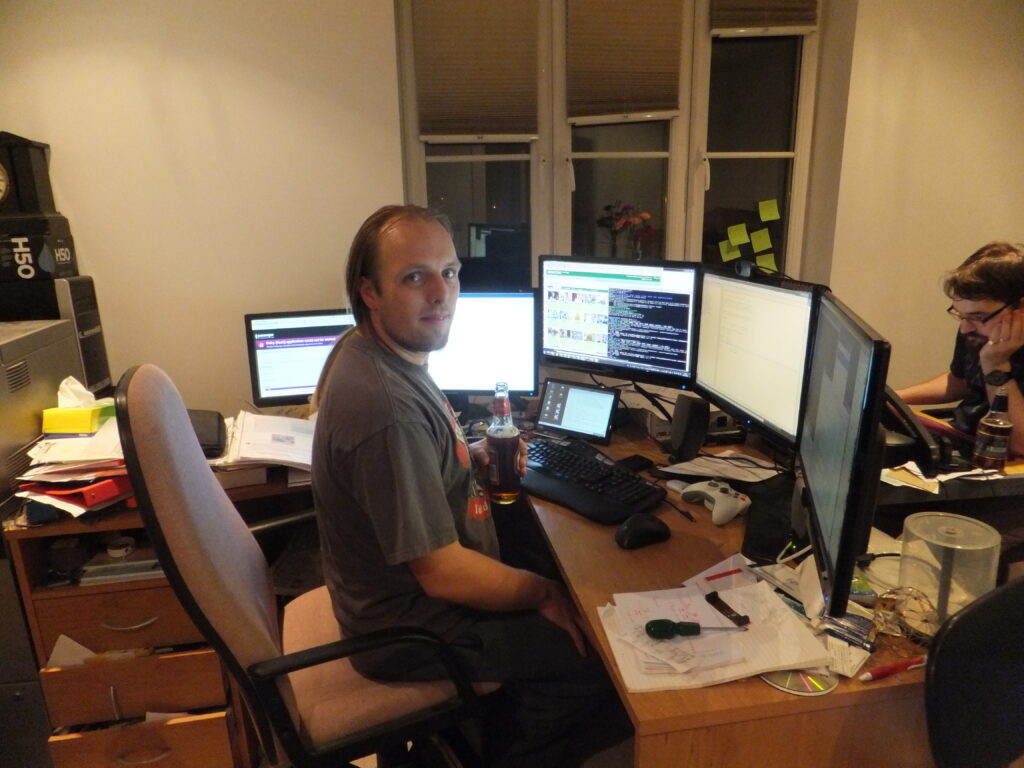
There was Milestone: Jethrik and the Three Rings Conference, of course, which ate up a lot of my time but then paid off wonderfully – the conference was a wonderful success, and our announcements about formalising our non-profit nature and our plans for the future were well-received by the delegates. A slightly lower-than-anticipated turnout (not least because of this winter ‘flu that’s going around) didn’t prevent the delegates (who’d come from far and wide: Samaritans branches, Nightlines, and even a representative from a Community Library that uses the software) from saying wonderful things about the event. We’re hoping for some great feedback to the satisfaction surveys we’ve just sent out, too.

Hot on the heels of those volunteering activities came my latest taped assessment for my counselling course at Aylesbury College. Given the brief that I was “a volunteer counseller at a school, when the parent of a bullied child comes in, in tears”, I took part in an observed, recorded role-play scenario, which now I’m tasked with dissecting and writing an essay about. Which isn’t so bad, except that the whole thing went really well, so I can’t take my usual approach of picking holes in it and saying what I learned from it. Instead I’ll have to have a go at talking about what I did right and trying to apply elements of counselling theory to justify the way I worked. That’ll be fun, too, but it does of course mean that the busy lifestyle isn’t quite over yet.
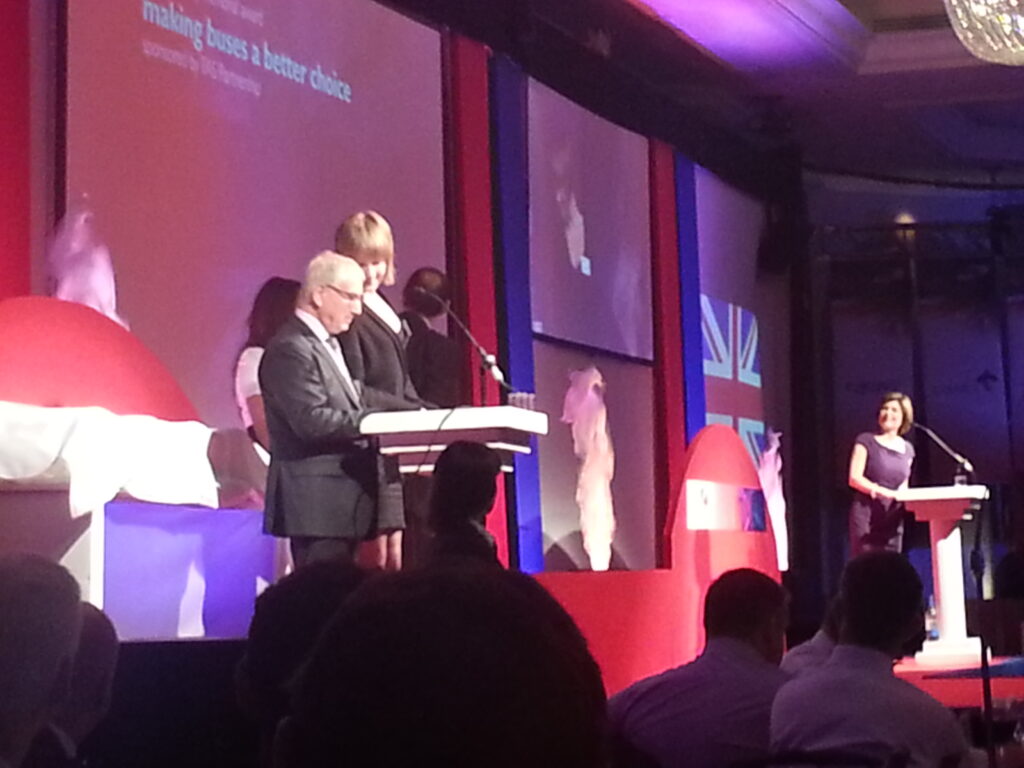
And then on Tuesday I was a guest at the UK Bus Awards, an annual event which my dad co-pioneered back in the mid-1990s. I’d been invited along by Transaid, the charity that my dad was supporting with his planned expedition to the North Pole before he was killed during an accident while training. I was there first and foremost to receive (posthumously, on his behalf) the first Peter Huntley Fundraising Award, which will be given each year to the person who – through a physical activity – raises the most money for Transaid. The award was first announced at my father’s funeral, by Gary Forster, the charity’s chief executive. Before he worked for the charity he volunteered with them for some time, including a significant amount of work in sub-Saharan Africa, so he and I spent a little while at the event discussing the quirks of the local cuisine, which I’d experienced some years earlier during my sponsored cycle around the country (with my dad).
So it’s all been “go, go, go,” again, and I apologise to those whose emails and texts I’ve neglected. Or maybe I haven’t neglected them so much as I think: after all – if you emailed me last week, right now that feels like months ago.